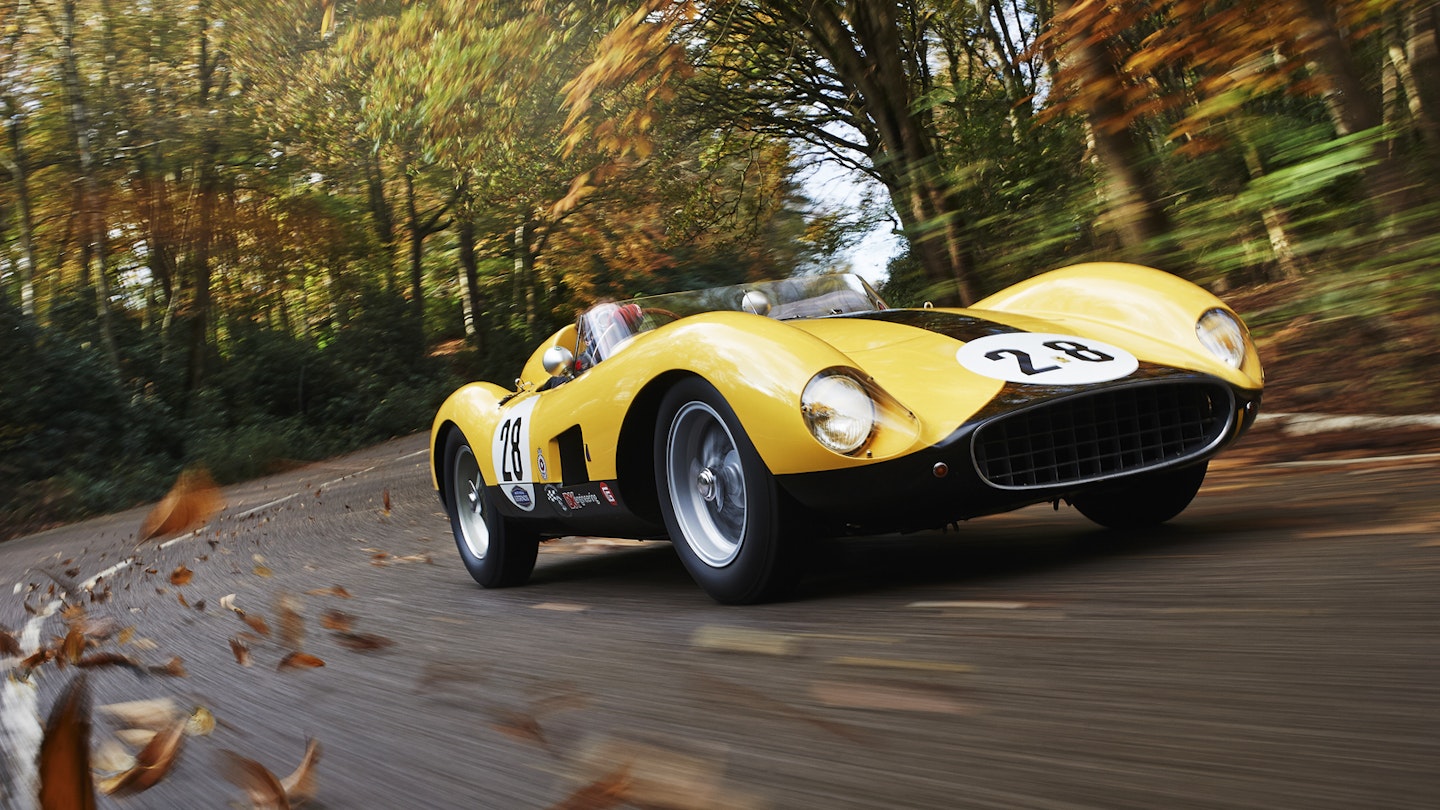A giant-killer awaits me in the autumn sunshine, its original yellow-and-black Belgian racing colours resplendent as the car stands ready for the track. The 500 TRC has a reputation for taking on and beating rivals with almost double its 2.0-litre engine’s capacity, and this very car finished first in class and seventh overall at the 1957 Le Mans 24 Hours, driven by Lucien Bianchi and Georges Harris. To put that into context, the first four cars home were Jaguar D-types and a Ferrari 315S V12 came fifth, with another D-type finishing sixth.
Exalted company indeed. This TRC finished seventh overall in the 1958 Targa Florio, having battled all through the event with 3.0-litre V12 Ferrari 250 TRs and ultra-lightweight Porsche 718 RSKs. Current owner and Ferrari authority, David Cottingham, calls it ‘the ultimate driver’s Ferrari of that period’ and has continued to campaign it since acquiring it. In fact, if it weren’t for him, chassis 0682 MDTR may have been lost for ever.
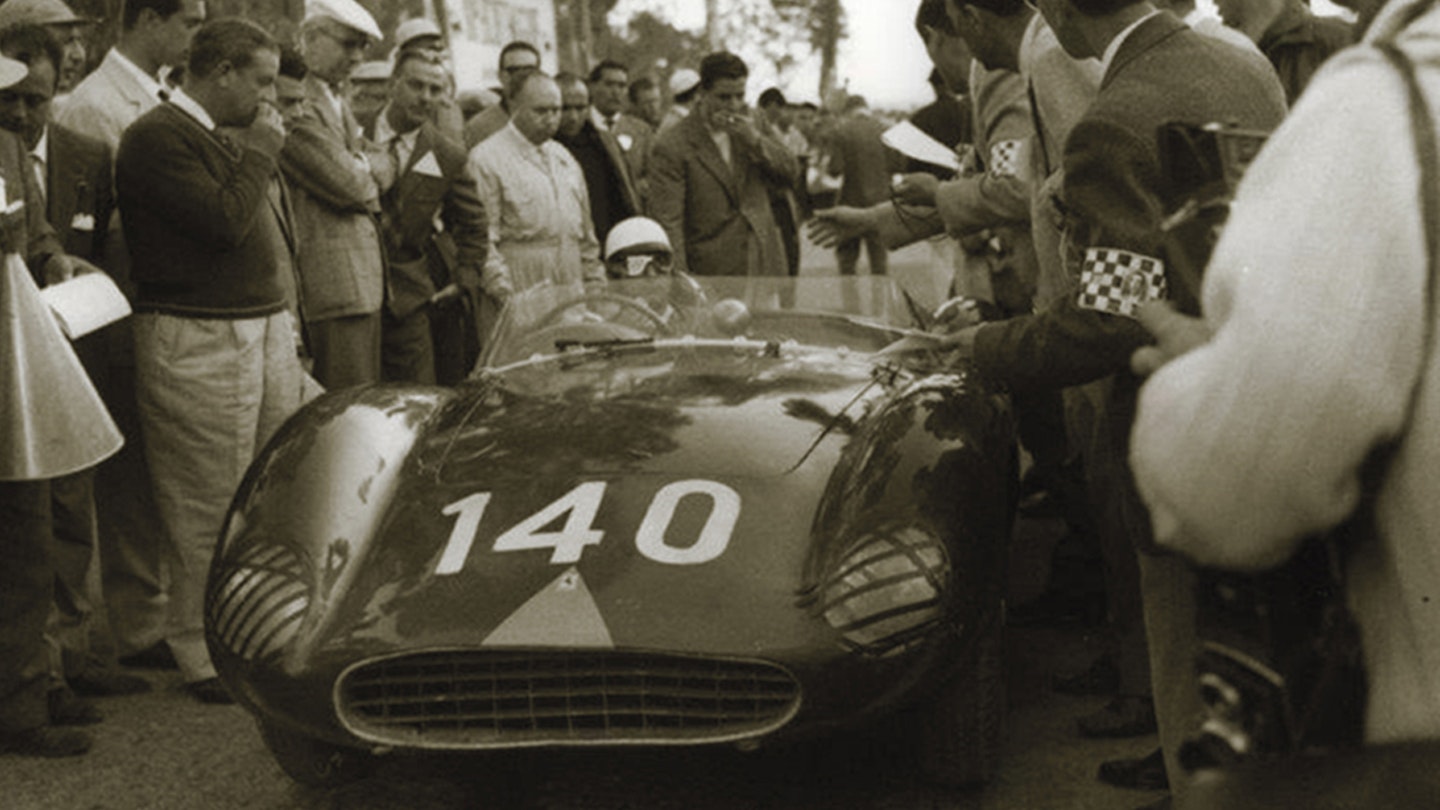
Urgent appointment
But more time for history later. Right now, my rear end has an urgent appointment with its driver’s seat. Without bothering to open the door, I swing a leg over the side and climb into the cockpit. I slither down into the low-slung hot seat, taking in the view down the long, elegant bonnet nestled between the sweeping front wings.
In period this car wouldn’t have been fitted with seatbelts, but today it has – and I’m glad. After buckling up, the controls are still reachable; I stretch my legs out horizontally to find the pedals while checking the rear visibility supplied by the small, Fifties-style bullet mirrors. I twist the red master switch to ‘on’ and turn the ignition key (on the extreme right of the dash) to the right, switch on the fuel pump and then yank a cord laying atop the transmission cover – this connects to the lever on the starter motor somewhere near my left shin. In the Fifties, without restricting belts, you’d just lean forward to reach the lever. The 2.0-litre, four-cylinder, double overhead cam Testa Rossa spins willingly, catches, and bellows into life.
I make sure the guard for reverse is in place on the gate and dip the clutch. I’ve been warned by David Cottingham’s son Jeremy that you have to be careful when changing gears to make absolutely certain the lever slots home.
With that in mind, I’m heartened to hear that familiar metal-to-metal clack as I slide the lever forward along the gate to select first, then take up more travel than I anticipate when I bring the clutch pedal up. Pulling the nose around towards the track, the pretty reasonable turning circle (reasonable for a racing car, anyway) means I don’t have to heave the car through a three-point turn, although I soon find the worm-and-sector steering is accurate, communicative and feels beautifully weighted, lightening up at speed, yet constantly retaining good feel.
This is a car you get used to quickly, and I’m soon feeling at ease.
Cammy delivery
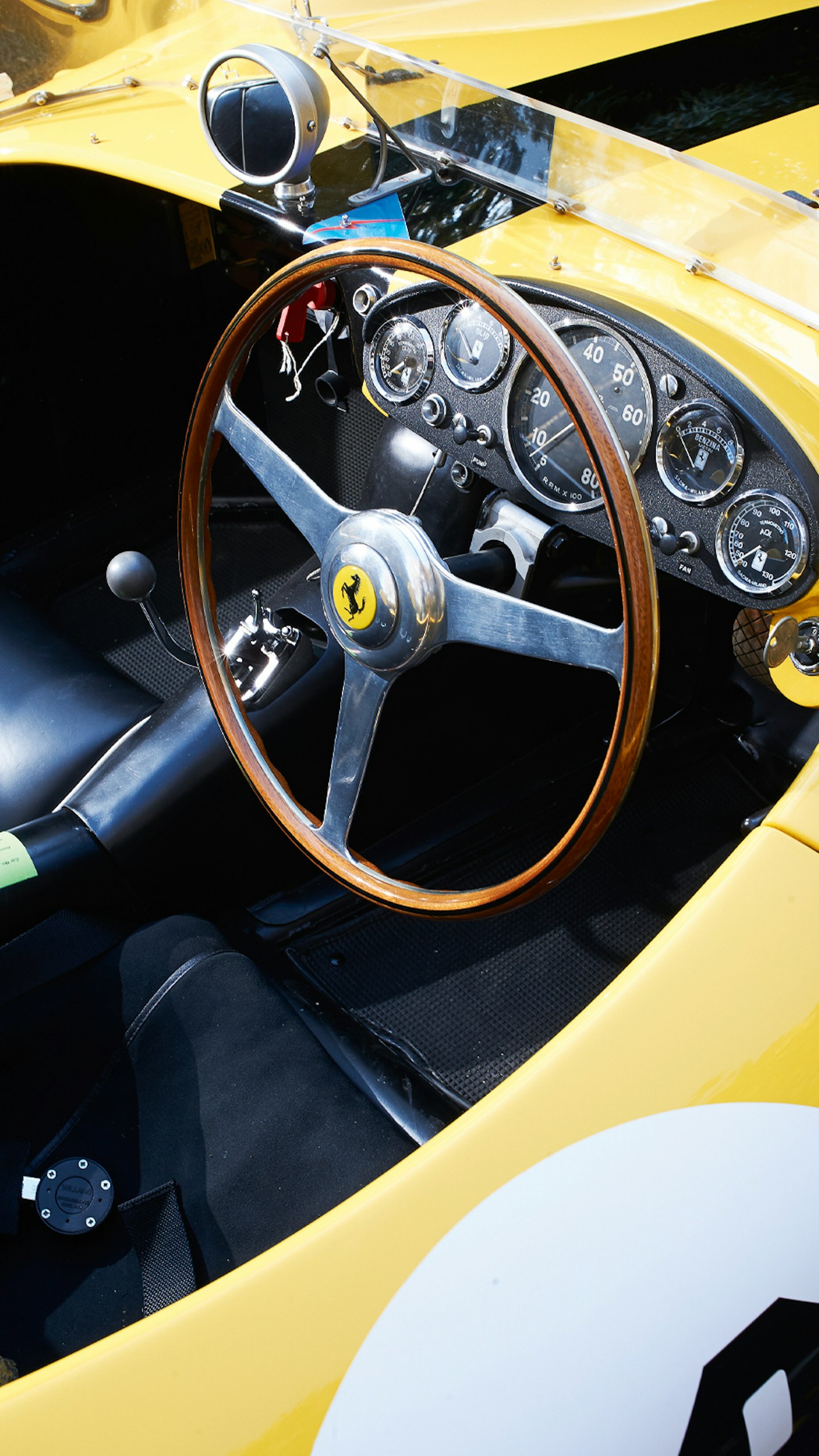
Off the cam, the 2.0-litre four-pot sputters and bangs – but once on the move, with two or three thousand revs on the clock, it sorts itself out and becomes very responsive to the throttle. From 4000rpm it shoves me back in the seat like a jet at take-off and feels like it will keep on accelerating like this for ever.
The surface is partly dry, partly wet, with plenty of slippery autumn leaves around to make things interesting. The grip from the tyres – 550L front and 600L rear 16-inch Dunlop Historic crossplies – is good, and snaking through tight successive corners I gradually allow myself to push harder and feel the back end begin to move. Cautiously, I start to enjoy myself.
Before too long, I’m driving the TRC quicker and quicker through the corners, its neutral handling instilling me with confidence. You don’t have to turn in early or late; you just take the line, put the power down progressively, drift across the apex and out. The car is so extraordinarily gentle, but I sense that if I get over-confident cornering on the wet leaves I’ll risk the front understeering off, so I resist temptation.
I’m later informed by David that my instincts were correct and in seriously wet race conditions they disconnect the front anti-roll bar to reduce understeer. It may be 60 years old, but the steering response is instant; there’s no lurch or yaw, and I’m able to make instinctive corrections on the tiller when the rear breaks away. Remembering Jeremy’s tip, I take special care when swapping cogs, making sure the ratio is fully engaged. The last thing I want is for it to jump out of gear and buzz that sweetest of straight-four engines. But it doesn’t happen and the gears continue to slide home satisfyingly every time.
Once back on the straight, I give it some stick. Holding it in third gear, the acceleration actually presses me back into the seat as the tachometer needle swings past 4500. At 4700 it all seems to get much smoother, and past 5000rpm it’s really flying.
Wailing banshee
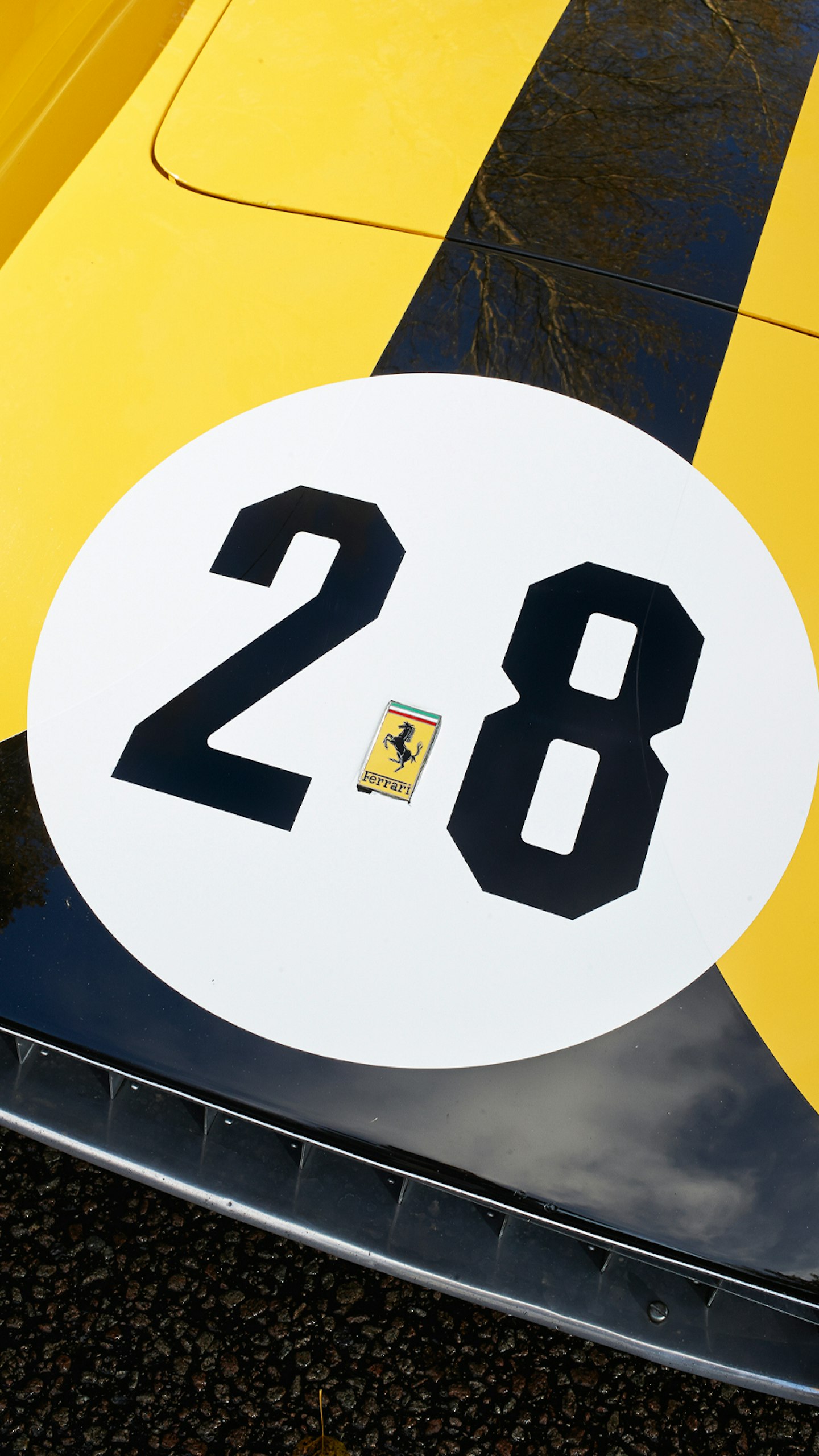
Still carrying its original Le Mans racing number 28 and wearing the yellow and black scheme of Jaques Swaters’ Ecurie National Belge, for a fleeting second the TRC and I are transported back to the middle of that night in 1957 as June 22 melded into June 23, Raymond Baxter commentating on the BBC Home Service: ‘Georges Harris and Lucien Bianchi in the Ferrari are well out in front…’
I hold the throttle open, gawk as it winds up to 6000 in third, pull the lever back into top gear and push the throttle pedal back down hard once again. The twin exhaust pipes exit a few feet away from my left ear, and at 5800rpm in top – almost 115mph – the Ferrari sounds like a wailing banshee with the background crackle of a deep, harmonising bass note. The faster the engine spins, the louder and more intoxicating it becomes, with the four-pot adding encouragement, seeming to yearn for more.
Approaching the end of the straight, I brake hard, blipping the throttle with the side of my right foot as the gearlever passes through neutral, depressing the clutch once again and slipping the lever home into third gear, simultaneously maintaining constant pressure on the centre pedal. My torso strains against the harness, but I make a mental note that, so far as I can tell from the cockpit, the nose doesn’t seem to dip under braking and the chassis remains quite unflustered through the corners, with no apparent flexing.
‘The 2.0-litre straight four may not be a very high-revving engine, but it delivers hill-conquering torque in spades’
David tells me that under race conditions the brakes are the chink in this car’s armour, with the 350 x 55mm drums struggling to stop 750kg of historic Ferrari driven in anger. Good to be warned in advance, but I didn’t expect modern disc-brake retardation qualities. In reality, although lacking the feel of a modern system, throughout the test the brakes are adequate and progressive.
The Aurelio Lampredi-designed 2.0-litre straight four may not be a very high-revving engine, but those four relatively large pots pumping power through perfectly spaced gear ratios deliver hill-conquering torque in spades. In top gear, the car feels lighter than its 750kg. It feels like it wants to fly. It’s also one of the most beautifully balanced and neutral handling front-engined sports cars that I’ve experienced. I could drive this beautiful yellow Ferrari all day long and never stop smiling.
Rich history
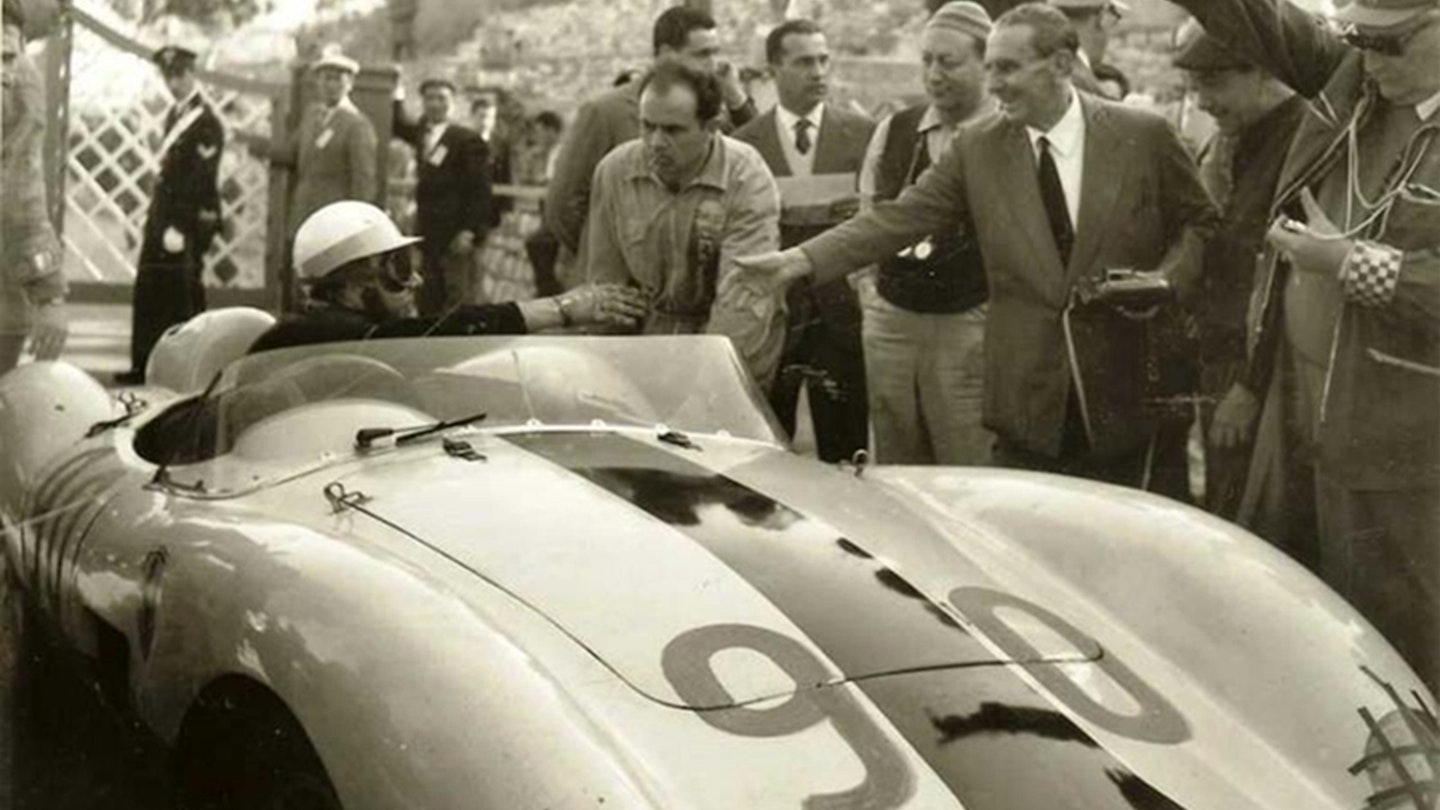
Sadly that isn’t going to happen, and eventually I have to pull in. Time to consider how this car came to be. The 500 TRC is an evolution of the 500 Mondial, which was created in 1954 around a 1984cc F2 engine designed by Aurelio Lampredi and aimed at class wins for privateer drivers.
The 500 Testa Rossa was unveiled at the New York Show in April 1956. It was the first Ferrari with a red cylinder head and cam covers and retained the gear driven twin-overhead camshaft design and hairpin-type valve springs of the original Mondial, but benefitted from a stronger crankshaft and conrods, and twin distributor ignition in place of the Mondial’s dual magnetos to fire the two plugs per cylinder.
Instead of the five-speed rear transaxle and de Dion rear suspension, the revised engine sent power via a four-speed, engine-mounted gearbox to a coil-sprung live axle located fore-aft with trailing arms and laterally with an A-bracket.
Up front the 500 TR carried over the double wishbone and coil-spring suspension that had been introduced with the series two Mondial. Of the 19 cars built, three were bodied by Touring of Milan. These are easily identified by their cutaway front wings, possibly to aid brake cooling.
The design team of Alberto Massimino, Luigi Bellantani, Andrea Freschetti and engine maestro Vittorio Jano were aiming at the new-for-1957 FIA Appendix C sports car rules when they created the 500 TRC. For this, coachbuilder Scaglietti had to add a passenger door in addition to the driver’s, a full-width windscreen, an apology for a hood and a passenger seat. The wheelarch cutaway was retained.
In April 1957, Ferrari 500 TRC chassis 0682 MDTR was bought from the factory by Jaques Swaters, the Belgian-based Ferrari dealer who ran the Equipe National Belge race team, latterly (and famously) known as the Ecurie Francorchamps. The car was successfully raced many times in 1957, including a second-in-class finish at Spa, first in class at Le Mans in the hands of Lucien Bianchi and Georges Harris and sixth at the Daily Express meeting at Silverstone.
In 1958 Equipe National Belge sold 0682 MDTR back to the factory and by February 1958 it was taken over by Prince Gaetano Starrabba di Giardinelli and regularly raced by him. Starrabba enjoyed great success in the car, including first in class and seventh overall in the Targa Florio on May 11, 1958.
Golden opportunity

However, on May 24, 1959 the car was crashed while on the Targa with Starrabba and Domenico Lo Coco. The damaged Ferrari was then bought by Robert Jenny, a Swiss-based dealer. Jenny later sold the car on to Rob de la Rive Box, who in turn sold it on to Sid Pyle, for whom David maintained and raced a 500 TR. In 1978, Pyle offered Cottingham the TRC; it was an opportunity he wasn’t about to let go.
Although the TRC had been dismantled at some point following the Targa crash, no restoration had been attempted – and that process consumed 10 years of David Cottingham’s spare time. He says the engine wasn’t a big problem. ‘It wasn’t broken; all the castings were okay and it was in generally such good order, we are pretty sure that after Ecurie Francorchamps sold the car in 1958 it received a new engine at the factory.
However, when Ferrari was running the car there was a documented history of liner and cylinder head leakage problems. These engines have a cylinder block that embodies the combustion chambers instead of a two-piece construction with a head gasket and there are screw-in cylinders. If the engine has been excessively overheated, these frequently leak at their joints with the combustion chamber rim.
‘It is important to build these engines carefully if you want reliability. You have to keep an eye on the alloy mushroom cam followers. They run up and down in sleeves, and carry little rollers that run on the camshaft and push on the top of the valves. It can be a difficult engine to get right – but once it is, it will be reliable.
‘That engine has been very good to me, and mechanically the car is exactly as it was when it ran at Le Mans. I had the honour of meeting Georges Harris and asked him how he managed to look after the engine so it would last for 24 hours. He said, “Every time I went down the Mulsanne Straight I lifted my foot off the gas pedal, the oil came up the bores, and then I put my foot down again”.
‘When the car was finished, it was still sitting a little bit high at the rear. It didn’t have much caster angle and it was really light on the steering, but that was easily and quickly corrected. I enjoy driving it so much. It is my sort of car; I can drive it right at the limit and then say I wish I had just a little more power.
‘The Achilles heel has always been the drum brakes – they aren’t too fantastic. As soon as they start to smell, I back off otherwise they’ll cook. But it is very competitive on hill climbs because the acceleration is so good.’
Worth the wait
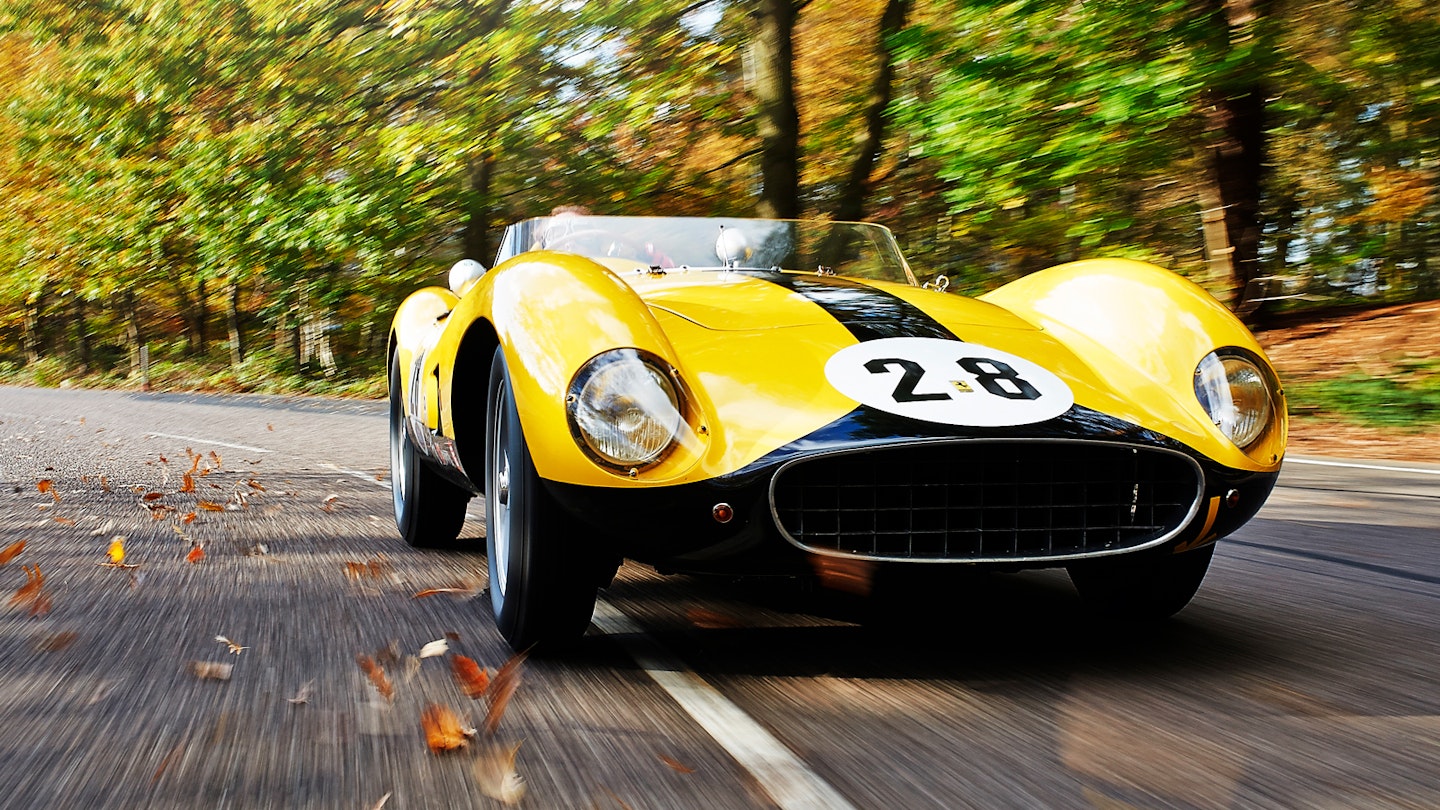
Since its restoration it has been regularly driven by David, and in recent years by his son James, in all the classic events including Donington, Brands Hatch, Silverstone, Spa, Mugello, Nürburgring, Monaco, Monza, Imola, Dijon, Portimao, Bahamas and, of course, Goodwood. ‘I well remember driving it for the first time after the work was completed at our workshop in 1989,’ says David. ‘It looked splendid, just as it did when it was first built. I knew then we’d got the restoration right; it was so exciting and such a thrill to drive it after so many years of hard graft.’
I get the impression that for David this is a car for life. After just one day with it I can see why.
Ferrari 500TRC
Engine 1984cc dohc in-line four-cylinder, 8.5:1 compression ratio, two Weber 40DCO/3 carburettors Bore x stroke 78mm x 90mm
Power and torque 180bhp @ 7000rpm; 148lb ft @ 5500rpm
Transmission Four-speed manual, rear-wheel drive
Steering Worm and sector
Suspension Front: independent, coil springs, double wishbone, Houdaille dampers and anti-roll bar. Rear: live axle, trailing arms, coil springs, Houdaille dampers and anti-roll bar
Brakes Drums front and rear
Weight 750kg (1753lb)
Performance Top speed: 139mph (with current gearing)
Price new £1300
Current value $5.5m (£3.64m)
